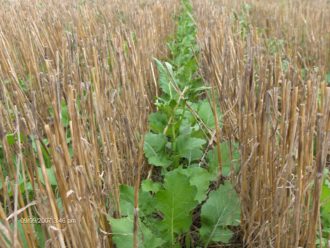Dan Forgey has always had an abiding respect for the land that he has farmed for more than 40 years, which is why, as manager of the 8,500-acre Cronin Farms in Gettysburg, S.D., he strives to build soil health—and yields—sustainably. First, he shifted the farm to 100 percent no-till in 1993, around the time that other innovative growers in his area were doing the same. Then in 2006, after spending years developing diverse crop rotations, he received a SARE grant to test the introduction of cover crops into his system, a move that has given him higher yields with fewer inputs, and therefore better profits. Now that he has found success with these methods, he is showing his neighbors how to do the same.
“This is what the country needs. Between cover crops and no-till we are doing things to better the soil nature’s way,” Forgey says. Over the years, he has diversified the farm to include 12 crops—including grains, oilseed crops and forages for his 750-head cow-calf operation. He plants them in long rotations in order to combat weeds, which present a major challenge in no-till systems.
Assisted by researchers from USDA Agricultural Research Service, South Dakota State University and other institutions, Forgey used SARE funds to conduct field trials of different cover crop mixes planted in the fall before no-till corn. For each mix, the group took numerous measurements, tracking moisture use, carbon sequestration, weed suppression, nitrogen availability, biomass and subsequent corn yields.
They found that a mix of turnips, cowpeas and lentils increased corn yields by 18-20 bushels per acre compared to control plots. This translated to increased revenue of $14 per acre, minus the cost of cover crop seeds.
Encouraged by the small-scale results, Forgey has since begun planting cover crops on hundreds of acres. “We are just finding out what the potentials are,” he says.
Now, Forgey is helping other growers adopt the soil-building strategies. Potter County, where Forgey lives, and nearby Sully County have become a hotbed of no-till in the last 20 years, where an estimated 80-90 percent of growers now use the practice. But cover crops have been slower to catch on, partly because not enough growers have demonstrated which covers work well in local growing conditions.
Forgey has worked hard to share his success with cover crops with neighbors. He has conducted on-farm tours, held field days, spoken at regional conferences and recently been profiled in the national agricultural media. Many of his neighbors have taken notice.
Seven producers—their operations ranging in size from 3,500 to 18,000 acres— planted cover crops for the first time in 2008 after seeing Forgey’s plots. “They see and hear the benefit of cover crops in a no till environment and it helps them understand the soil heath aspect,” he says.

